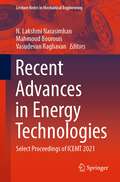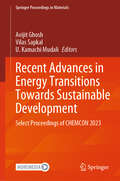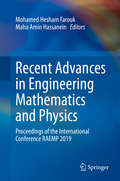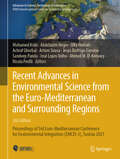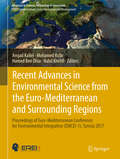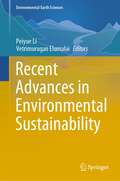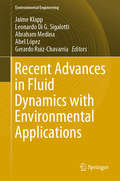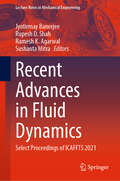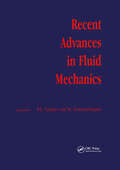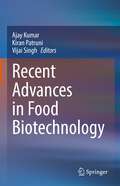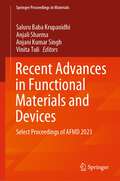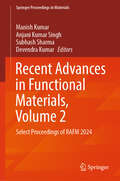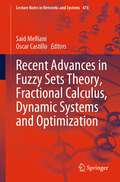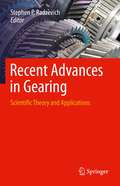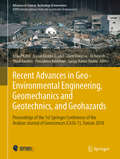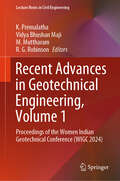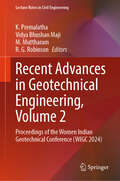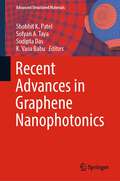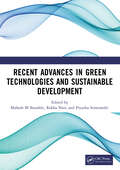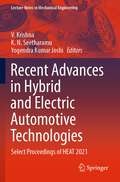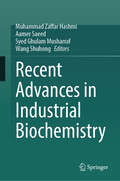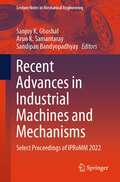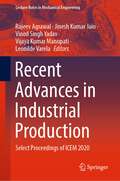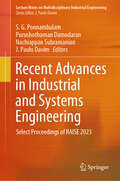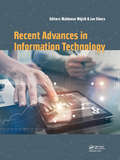- Table View
- List View
Recent Advances in Energy Technologies: Select Proceedings of ICEMT 2021 (Lecture Notes in Mechanical Engineering)
by Vasudevan Raghavan N. Lakshmi Narasimhan Mahmoud BourouisThis book presents the select proceedings of the first International Conference on Energy and Materials Technologies (ICEMT) 2021, organized by the Department of Mechanical Engineering, Sri Sivasubramaniya Nadar College of Engineering, Kalavakkam, India. It covers the recent technologies in two broad thematic areas: energy and materials. Various topics covered in this book include hybrid energy, advanced energy systems, energy management, energy policy, geothermal, nuclear energy, bio-energy, waste to energy, power plants, and automotives. The book will be useful for students, researchers, and professionals in the area of mechanical engineering, especially various domains of energy.
Recent Advances in Energy Transitions Towards Sustainable Development: Select Proceedings of CHEMCON 2023 (Springer Proceedings in Materials #67)
by U. Kamachi Mudali Avijit Ghosh Vilas SapkalThis book presents the select proceedings of the 76th Indian Chemical Engineering Congress (CHEMCON–2023) which was focused on energy transitions towards sustainable development. It includes the latest developments in the energy science and engineering towards sustainable development. It also discusses the role of machine learning & IoT in chemical engineering. Various topics covered include chemical engineering, process engineering, biofuel and biosafety, advanced techniques for waste-to-wealth generation, bioinformatics for energy transition, green and renewable membranes and carbon capture sequestration and utilization, electrochemical energy, biodiesel and bioplastics toward low-carbon footprint and sustainable food packaging. The book will be a valuable reference for researchers and professionals interested in sustainable energy and allied fields.
Recent Advances in Engineering Mathematics and Physics: Proceedings of the International Conference RAEMP 2019
by Mohamed Hesham Farouk Maha Amin HassaneinThis book gathers the proceedings of the 4th conference on Recent Advances in Engineering Math. & Physics (RAEMP 2019), which took place in Cairo, Egypt in December 2019. This international and interdisciplinary conference highlights essential research and developments in the field of Engineering Mathematics and Physics and related technologies and applications. The proceedings is organized to follow the main tracks of the conference: Advanced computational techniques in engineering and sciences; computational intelligence; photonics; physical measurements and big data analytics; physics and nano-technologies; and optimization and mathematical analysis.
Recent Advances in Environmental Science from the Euro-Mediterranean and Surrounding Regions: Proceedings of 3rd Euro-Mediterranean Conference for Environmental Integration (EMCEI-3), Tunisia 2021 (Advances in Science, Technology & Innovation)
by Sandeep Panda Mohamed Ksibi Abdelazim Negm Achraf Ghorbal Olfa Hentati Arturo Sousa Jesus Rodrigo-Comino José Lopes Velho Ahmed M. El-Kenawy Nicola PerilliThis edited book includes over one hundred and eighty short papers that were presented during the third edition of EMCEI, which was held in Sousse, Tunisia, in June 2021. Nowadays, experts as well as most of the general public know that the Mediterranean and surrounding regions are facing environmental degradation that is accelerating at an unprecedented rate. The main causes are the natural and human induced climate change, increasing pollution, urban growth, and the overexploitation and unsustainable use of resources due to rapid population growth. The effects are seen in several indicators such as the warming, more frequent extreme events, severe droughts, water shortages, contraction of natural resources, changes in land use and landscape deterioration, decreasing agricultural yields, biodiversity loss, deterioration of the ecosystems, corrosion of the natural coastal environment, sea-level rise, and ocean acidification. In addition to these more recent issues, the Mediterranean and surrounding region naturally experience a number of hazards such as floods, droughts, desertification, fires, catastrophic forest diebacks, earthquakes, and volcanic eruptions. By presenting a wide range of environmental topics and new findings relevant to a variety of problems in these regions, this book appeals to anyone working in the subject area and especially students interested in learning more about new developments in environmental research initiatives in light of the worsening environmental degradation of the Mediterranean and surrounding areas, making environmental and resource protection an increasingly important issue that impedes sustainable development and social well-being. The book addresses emerging environmental issues along with new challenges by focusing on innovative approaches that contribute to achieving a sustainable environment in and around the Mediterranean Sea and by highlighting to decision makers from relevant sectors the environmental considerations that should be integrated into their own activities.
Recent Advances in Environmental Science from the Euro-Mediterranean and Surrounding Regions: Proceedings of Euro-Mediterranean Conference for Environmental Integration (EMCEI-1), Tunisia 2017 (Advances in Science, Technology & Innovation)
by Amjad Kallel Mohamed Ksibi Hamed Ben Dhia Nabil KhélifiThis volume includes the papers presented during the 1st Euro-Mediterranean Conference for Environmental Integration (EMCEI) which was held in Sousse, Tunisia in November 2017. This conference was jointly organized by the editorial office of the Euro-Mediterranean Journal for Environmental Integration in Sfax, Tunisia and Springer (MENA Publishing Program) in Germany. It aimed to give a more concrete expression to the Euro-Mediterranean integration process by supplementing existing North-South programs and agreements with a new multilateral scientific forum that emphasizes in particular the vulnerability and proactive remediation of the Euro-Mediterranean region from an environmental point of view. This volume gives a general and brief overview on current research focusing on emerging environmental issues and challenges and its applications to a variety of problems in the Euro-Mediterranean zone and surrounding regions. It contains over five hundred and eighty carefully refereed short contributions to the conference. Topics covered include (1) innovative approaches and methods for environmental sustainability, (2) environmental risk assessment, bioremediation, ecotoxicology, and environmental safety, (3) water resources assessment, planning, protection, and management, (4) environmental engineering and management, (5) natural resources: characterization, assessment, management, and valorization, (6) intelligent techniques in renewable energy (biomass, wind, waste, solar), (7) sustainable management of marine environment and coastal areas, (8) remote sensing and GIS for geo-environmental investigations, (9) environmental impacts of geo/natural hazards (earthquakes, landslides, volcanic, and marine hazards), and (10) the environmental health science (natural and social impacts on Human health). Presenting a wide range of topics and new results, this edited volume will appeal to anyone working in the subject area, including researchers and students interested to learn more about new advances in environmental research initiatives in view of the ever growing environmental degradation in the Euro-Mediterranean region, which has turned environmental and resource protection into an increasingly important issue hampering sustainable development and social welfare.
Recent Advances in Environmental Sustainability (Environmental Earth Sciences)
by Peiyue Li Vetrimurugan ElumalaiThis volume presents a selection of contributions from international environmental scholars and water researchers. The book includes significant topics on earth and environmental sciences such as water resources and water quality, soil quality and sediment contamination, air pollution and climate change, and issues related to clean production. The themes were chosen according to the current global issues covering major aspects of their respective fields. The aim of the book was to discover advances, experiences and innovative ideas on issues related to earth and environmental sciences, to share experiences and research findings, discuss challenges encountered and solutions in order to have opportunities to establish productive new academic and industry research collaborations.
Recent Advances in Fluid Dynamics with Environmental Applications (Environmental Science and Engineering)
by Leonardo Di G. Sigalotti Jaime Klapp Abraham Medina Abel López Gerardo Ruiz-ChavarríaThis book gathers selected contributions presented at the Enzo Levi and XX Annual Meeting of the Fluid Dynamic Division of the Mexican Physical Society in 2014. The individual papers explore recent advances in experimental and theoretical fluid dynamics and are suitable for use in both teaching and research. The fluid dynamics applications covered include multiphase flows, convection, diffusion, heat transfer, rheology, granular materials, viscous flows, porous media flows, geophysics and astrophysics.The contributions, some of which are introductory and avoid the use of complicated mathematics, are suitable for fourth-year undergraduate and graduate students. Accordingly, the book is of immense benefit to these students, as well as to scientists in the fields of physics, chemistry and engineering with an interest in fluid dynamics from experimental and theoretical points of view.
Recent Advances in Fluid Dynamics: Select Proceedings of ICAFFTS 2021 (Lecture Notes in Mechanical Engineering)
by Jyotirmay Banerjee Ramesh K. Agarwal Rupesh D. Shah Sushanta MitraThis book presents select proceedings of the International Conference on Advances in Fluid Flow and Thermal Sciences (ICAFFTS 2021) and summarizes the modern research practices in fluid dynamics and fluid power. The content of the book involves advanced topics on turbulence, droplet deposition, oscillating flows, wave breaking, spray structure and its atomization and flow patterns in mini and micro channels. Technological concerns relevant to erosion of steam turbine blade due to droplets, influence of baffle cut and baffle pitch on flow regime, bubble formation and propagation in pool boiling, design optimization of flow regulating valves are included in the book. In addition, recent trends in small-scale hydropower plant and flow stability issues in nanofluids, solar water heating systems and closed-loop pulsating heat pipes are discussed. Special topics on airflow pattern in railway coach and vortex tube are also included. This book will be a reliable reference for academicians, researchers and professionals working in the areas of fluid dynamics and fluid power.
Recent Advances in Fluid Mechanics
by P. L. Sachdev M. VenkatachalappaThis unique monograph presents a collection of papers by leading international fluid dynamicists and applied mathematicians demonstrating the latest state of the art in fluid mechanics. The vast scope and breadth of this subject is illustrated with sections covering evolution in flow problems, convection and transport phenomena, dynamics of atmosphere, and wave propagation.
Recent Advances in Food Biotechnology
by Ajay Kumar Vijai Singh Kiran PatruniThis book highlights important aspects of food biotechnology. It is very thoughtfully divided into five sections. The first section introduces the readers to food biotechnology and discusses functional foods, use of plant and animal biotechnology in improving food quality. The second section deals with food microbiology and includes topics such as application of microbial surfactants, use of probiotics, beneficial microorganisms used in food industry etc. The third section describes important macro and micromolecules in foods. It includes chapters on food enzymes, gluten free formulations, use of biopolymers, biofortification of food and other important topics. The next section discusses novel technologies such as use of nanotechnology in food industry, reverse micelle techniques, genome editing in food crops etc. The book culminates with a section on food quality and management. It describes important topics about biosafety and regulatory issues in food biotechnology. This book is meant for students, researchers and course instructors in food science, food technology and biotechnology. It is also useful for industry experts in the area of food technology.
Recent Advances in Functional Materials and Devices: Select Proceedings of AFMD 2023 (Springer Proceedings in Materials #37)
by Saluru Baba Krupanidhi Anjani Kumar Singh Anjali Sharma Vinita TuliThe book presents the select proceedings of 2nd International Conference on Advanced Functional Materials and Devices (AFMD-2023). It covers the latest research in the area of functional materials. Various topics covered in this book include 2D materials, biomaterials, materials for environmental studies, DFT and solar simulation of materials, perovskite and double perovskite materials, luminescent materials, smart materials, materials for energy conversion and storage, smart materials, advanced functional materials, polymeric materials, composites, liquid crystals, materials for sustainable development, nanomaterials and thin films, smart devices and quantum dots synthesis technique, and characterization tools with application in smart devices. This book is for researchers and professionals working on various functional materials for device applications.
Recent Advances in Functional Materials, Volume 2: Select Proceedings of RAFM 2024 (Springer Proceedings in Materials #69)
by Manish Kumar Devendra Kumar Anjani Kumar Singh Subhash SharmaThis volume presents the select proceedings of International Conference on Recent Advances in Functional Materials (RAFM 2024). It covers a wide range of topics such as multifunctional materials, 2D materials, biomaterials, materials for environmental studies, DFT and solar simulation of materials, perovskite and double perovskite materials, luminescent materials, smart materials, materials for energy conversion and storage, smart materials, advanced functional materials, polymeric materials, composites, liquid crystals, materials for sustainable development, nanomaterials and thin films, smart devices and quantum dots synthesis technique, and characterization tools with application in smart devices. The book will be useful for researchers and professionals working in various areas of materials science.
Recent Advances in Fuzzy Sets Theory, Fractional Calculus, Dynamic Systems and Optimization (Lecture Notes in Networks and Systems #476)
by Oscar Castillo Said MellianiWe describe in this book recent advances in fuzzy sets theory, fractional calculus, dynamic systems, and optimization. The book provides a setting for the discussion of recent developments in a wide variety of topics including partial differential equations, dynamic systems, optimization, numerical analysis, fuzzy sets theory, fractional calculus, and its applications. The book is aimed at bringing together contributions from leading academic scientists, researchers, and research scholars to exchange and share their experiences and research results on all aspects of applied mathematics, modeling, algebra, economics, finance, and applications. It also provides an interdisciplinary platform for researchers, practitioners, and educators to present the most recent innovations, trends, and concerns as well as practical challenges encountered and solutions adopted in the fields of applied mathematics. The published chapters address various aspects of academic scientists, researchers, and research scholars in many variety mathematical topics.
Recent Advances in Gearing: Scientific Theory and Applications
by Stephen P. RadzevichThis book presents the most up-to-date accomplishments in gear design and gear production, detailing theory of gearing and its application. As an enormous number of gears are used in such sectors as automobiles, aerospace, machines, and similar industries, even a very small improvement in the gear design or production, for example a 10 cent savings on each gear, can result in huge of savings in manufacturing, underscoring critical importance of the subject of the book. Giving a solid background in theory together with the latest advances in design and production, the book is ideal for product designers working in numerous industries. The volume also serves as a useful supplement to required texts well for students in mechanical and industrial engineering as it helps establish a scientific foundation to the subject, and facilitates a systematic learning process of gear kinematics, gear geometry, gear design, gear production/finishing operations, and related competencies.
Recent Advances in Geo-Environmental Engineering, Geomechanics and Geotechnics, and Geohazards: Proceedings of the 1st Springer Conference of the Arabian Journal of Geosciences (cajg-1), Tunisia 2018 (Advances in Science, Technology & Innovation)
by Sanjay Kumar Shukla Amjad Kallel Zhen-Dong Cui Zeynal Abiddin Erguler Ali Karrech Murat Karakus Pinnaduwa KulatilakeThis edited volume contains the best papers in the geo-engineering field accepted for presentation at the 1st Springer Conference of the Arabian Journal of Geosciences, Tunisia 2018. In addition, it includes 3 keynotes by international experts on the following topics: <P><P>1. A new three-dimensional rock mass strength criterion <P><P>2. New tools and techniques of remote sensing for geologic hazard assessment <P><P>3. Land subsidence induced by the engineering-environmental effects in Shanghai China <P><P>The book is useful for readers who would like to get a broad coverage in geo-engineering. It contains 11 chapters covering the following main areas: (a) Applications in geo-environmental engineering including soil remediation, (b) Characterization of geo-materials using geological, geotechnical and geophysical techniques, (c) Soil improvement applications, (d) Soil behaviour under dynamic loading, (e) Recent studies on expansive soils, (f) Analytical and numerical modelling of various geo-structures, (g) Slope stability, (h) Landslides, (i) Subsidence studies and (j) Recent studies on various other types of geo-hazards.
Recent Advances in Geotechnical Engineering, Volume 1: Proceedings of the Women Indian Geotechnical Conference (WIGC 2024) (Lecture Notes in Civil Engineering #577)
by R. G. Robinson M. Muttharam K. Premalatha Vidya Bhushan MajiThis book presents the select proceedings of the First Women Indian Geotechnical Conference (WIGC) 2024 showcasing the overarching theme of "Geotechnics for Sustainable and Resilient Infrastructure." The book presents cutting-edge contributions from distinguished women geotechnical engineers and esteemed professors across the field of geotechnical engineering. Encompassing a broad spectrum of topics, the contributions in this volume cover pivotal areas, such as geomaterial characterization, sustainable waste management, geoenvironmental engineering, foundation engineering, landslides and slope stability, ground improvement, soft clay engineering, AI/ML applications in geotechnical engineering, and illuminating case studies in the field. This book will prove useful to graduate students, researchers, academics, and professional engineers working in geotechnical engineering, civil engineering, and geological engineering.
Recent Advances in Geotechnical Engineering, Volume 2: Proceedings of the Women Indian Geotechnical Conference (WIGC 2024) (Lecture Notes in Civil Engineering #578)
by R. G. Robinson M. Muttharam K. Premalatha Vidya Bhushan MajiThis book presents the select proceedings of the First Women Indian Geotechnical Conference (WIGC) 2024 showcasing the overarching theme of "Geotechnics for Sustainable and Resilient Infrastructure." The book presents cutting-edge contributions from distinguished women geotechnical engineers and esteemed professors across the field of geotechnical engineering. Encompassing a broad spectrum of topics, the contributions in this volume cover pivotal areas, such as geomaterial characterization, sustainable waste management, geoenvironmental engineering, foundation engineering, landslides and slope stability, ground improvement, soft clay engineering, AI/ML applications in geotechnical engineering, and illuminating case studies in the field. This book will prove useful to graduate students, researchers, academics, and professional engineers working in geotechnical engineering, civil engineering, and geological engineering.
Recent Advances in Graphene Nanophotonics (Advanced Structured Materials #190)
by Sudipta Das Shobhit K. Patel Sofyan A. Taya K. Vasu BabuThere are growing advantages to the use of graphene-based nanophotonics in communication, sensing, security, safety, spectroscopy, manufacturing, biomedicine, agriculture, imaging, and other fields. These advantages, as well as the numerous challenges associated with this technology and proposed solutions to these challenges, are summarized in this book. The key objective of the book is to serve as a single-source reference for the rapidly expanding application aspects of the technology of graphene-based nanophotonics, as well as the number of modules required for their successful implementation. This book seeks to give readers a comprehensive understanding of several elements of graphene-based nanophotonics, such as emerging application areas, the design and modelling of sensors, absorbers, optical fiber, encoders, etc. A complete view of the progress and breakthroughs in novel materials for sensing, detecting and encoding technology is presented. The book also emphasizes the consequences of THz signals on human health, as well as the environmental components of THz. This book will be of tremendous value for those with an interest in electronic engineering, particularly those keeping an eye on this emerging technology.
Recent Advances in Green Technologies and Sustainable Development
by Rekha Nair Piyusha Somvanshi Mahesh M BundeleRecent advances in green technologies and sustainable development deals with cutting-edge research and innovative ideas in different categories of green technologies and operational aspects of sustainable development including renewable energy sources, power systems, mathematical ecol□ogy, industrial technologies, construction and material sciences. The chapters are written by eminent and insightful authors to propose improvement and expansion of processes and applications connected to sustainable development. Environmental awareness and protection are one of the challenging issues of the new millennia. Industrialization and population explosion has opened new frontiers in the conservation of environmental protection. Rapid urbanization is proving to have direct consequences on the environment. The need of the hour is a balanced approach to multi layered conservative methods. Any sustainable devel□opment has a multifaceted approach, encompassing environmental, tech□nological, social, and economical developmental dimensions. This book focuses on these various issues in a progressive manner. The selected papers in this book have highlighted a plethora of issues related to green technology and sustainable development. Ample care has been given to selecting the papers which tried to bridge the gap between technological advancement and its impact on the environment.
Recent Advances in Hybrid and Electric Automotive Technologies: Select Proceedings of HEAT 2021 (Lecture Notes in Mechanical Engineering)
by V. Krishna K. N. Seetharamu Yogendra Kumar JoshiThis book presents the select proceedings of International Conference on Hybrid and Electric Automotive Technologies 2021 (HEAT 2021). It cover recent innovations in electric and hybrid-electric vehicles and autonomous vehicles. Various topics covered in this volume are batteries, battery cooling methodologies, use of nano-coolants, electrified powertrain systems and components, hybridisation infrastructure, energy storage, and many other topics of importance to the industry. The book will be useful for researchers and professionals working in the areas of automobile and vehicle engineering.
Recent Advances in Industrial Biochemistry
by Muhammad Zaffar Hashmi Aamer Saeed Syed Ghulam Musharraf Wang ShuhongBiochemistry is concerned with the chemical processes that occur within living organisms and microorganisms. There have been a number of publications focusing on biochemistry and its use for understanding biochemical and molecular mechanisms, with the majority of the literature focusing on bench scale items. To date there has not been a comprehensive work focusing on the techno-economic and industrial aspects of biochemistry from the microeconomic and pilot scales. This text covers current innovations and advances in plant biochemistry, animal biochemistry, microbial biochemistry and medicinal biochemistry plus potential uses of proteomics, genomics, recombinant DNA technology and protein application. Recent Advances in Industrial Biochemistry focuses on methods for recombinant proteins production and purification plus metabolic engineering and other source technologies from the industrial viewpoint, providing comprehensive, up-to-date information and evidence on contemporary development in the field of industrial biochemistry. The major focus of this book is the key issues, opportunities, approaches, advancements, products, innovations and technologies in current biochemistry from micro scale to production at pilot scale. Chapters highlight the many potential commercial prospects in various industries from food to to pharmaceuticals to bioenergy, providing a valuable and unique single resource for researchers.
Recent Advances in Industrial Machines and Mechanisms: Select Proceedings of IPRoMM 2022 (Lecture Notes in Mechanical Engineering)
by Sanjoy K. Ghoshal Arun K. Samantaray Sandipan BandyopadhyayThis book presents select proceedings of the Conference on Industrial Problems on Machines and Mechanisms (IPRoMM 2022). It presents a comprehensive coverage of the recent developments in analysis, design and manufacturing of a range of modern and next-generation industrial machines, and solutions to mitigate common and emerging problems in their maintenance and operation. The topics covered include design, manufacturing and performance analysis of mechanical and mechatronic machine components and assemblies, machine dynamics including rotor dynamics, vehicle dynamics, and multi-body dynamics, robotics and automation, hydraulic and pneumatic systems and control, vibration engineering, tribology, condition monitoring, failure analysis, manufacturing systems and processes, reliability and quality engineering, thermo-fluid and combustion systems, aerospace systems, acoustics, automotive engineering, etc. The book discusses theoretical and practical developments in these fields which have direct industrial relevance. The book serves as a valuable reference for researchers and professionals interested in analysis, design, manufacturing, maintenance, and operation of industrial machinery.
Recent Advances in Industrial Production: Select Proceedings of ICEM 2020 (Lecture Notes in Mechanical Engineering)
by Rajeev Agrawal Jinesh Kumar Jain Vinod Singh Yadav Vijaya Kumar Manupati Leonilde VarelaThis book presents the select proceedings of the International Conference on Evolution in Manufacturing (ICEM 2020), and examines a range of areas including evolution in manufacturing, intelligent networks, bio-Inspired models and algorithms, internet-of-things, and cyber manufacturing. This book intends to provide a contribution to the domain of collaborative and intelligent networks and systems to fill the gap in theories and practical applications through suitable methods and solutions applicable to a wide range of instances. Various topics covered include broad range of research challenges in the fields of artificial intelligence and addressing current and future trends in industry 4.0 oriented scenario, data analytics and big data, operation and manufacturing management. The book will be a valuable reference for beginners, researchers and professionals interested in artificial intelligence in engineering and production management and allied fields.
Recent Advances in Industrial and Systems Engineering: Select Proceedings of RAISE 2023 (Lecture Notes on Multidisciplinary Industrial Engineering)
by J. Paulo Davim Nachiappan Subramanian S. G. Ponnambalam Purushothaman DamodaranThis book presents select proceedings of the International Conference on Recent Advances in Industrial and Systems Engineering (RAISE 2023). It covers the latest research in the areas of industrial and systems engineering, including manufacturing, supply chain digitalization, resilience, and sustainability. Various topics covered in this book are additive manufacturing, artificial intelligence, modeling and simulation, production planning and management, digital manufacturing, and many more. This book is useful for researchers and professionals working in the areas of industrial and production engineering, supply chain management, quality control, and allied fields.
Recent Advances in Information Technology
by Waldemar Wόjcik & Jan SikoraInformation Technology is applicable in all areas of life. As a result, computer science is essential to imagine the modern world. Recent advances in information technology represents only a small part of today’s computing applications which were the subject of international cooperation between Kazakh, Ukrainian and Polish scientists. A wide range of issues and topics is addressed, from game theory to advanced control issues: - Application of new computational models and their security problems- The integro-differential game approach - Application of information technology for automated translation, from inflected languages to sign language- Mathematical problems of complex systems investigation under uncertainties Recent advances in information technology is of interest to academics and engineers, and to professionals involved in information technology and its applications.
